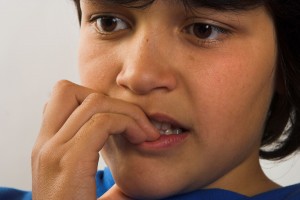Imagine you are standing outside and you notice that the sky has darkened, the clouds seem a bit lower and the leaves are rustling in the trees. Knowing that these are all signs telling you it is going to rain, you walk a bit faster to your destination and avoid getting wet.
 Now imagine that you are in the waiting room at the dentist and you notice that your palms are sweaty and your heart is beating faster than usual. Knowing that these are also signs, not of rain but of anxiety, tells you it is time to take a deep breath and relax because it’s just a routine cleaning and you have the best dentist in town.
Now imagine that you are in the waiting room at the dentist and you notice that your palms are sweaty and your heart is beating faster than usual. Knowing that these are also signs, not of rain but of anxiety, tells you it is time to take a deep breath and relax because it’s just a routine cleaning and you have the best dentist in town.
Anxiety, which is characterized as “a state of apprehension or worry about a danger or threat that might occur” is a normal feeling, one that everyone feels at some point in their lives and that can even be helpful in certain situations. Anxiety is your brain warning you to be on alert because something bad may happen, which is an important survival tool in certain situations.
Anxiety becomes a disorder when it:
- persists beyond what is developmentally appropriate
- interferes with a child’s ability to function or
- is ongoing or excessive.
Although the DSM-V lists nine different anxiety disorders, those most commonly seen in children and adolescents are:
- separation anxiety disorder
- selective mutism
- specific phobia
- social anxiety disorder
- generalized anxiety disorder
- panic attacks
Learning to identify the physical experience of anxiety is an important first step in learning to effectively cope with and decrease feelings of anxiety. Some common physical cues for anxiety are:
- upset stomach or feeling butterflies in your stomach
- face feeling flushed
- increase in heart rate
- sweating
- breathing more quickly
Children and adolescents who are struggling with anxiety may need help learning to identify anxious feelings in their bodies. A therapist can help your child learn how to identify her own physical cues for anxiety and teach her the coping skills necessary to effectively deal with her anxiety. Cognitive Behavior Therapy has been proven as an effective method for the treatment of childhood anxiety disorders.
In addition to learning about the physical cues to anxiety, clients will learn about how their thoughts, emotions and behaviors affect their anxiety. CBT therapists teach clients to understand the different parts of their anxiety in order to cope with and decrease those feelings. Some of the techniques children learn include relaxation, changing maladaptive thought patterns and engaging in gradual exposure to anxiety-provoking situations. With the help of a therapist, children and adolescents who struggle with anxiety can stop getting stuck in the rain.





